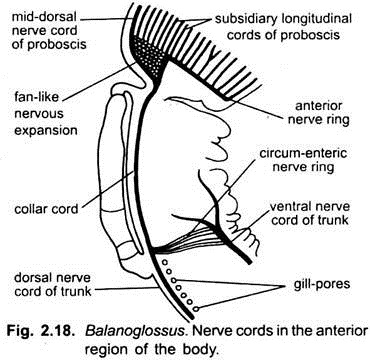The nervous system of Balanoglossus is of a very primitive type resembling that of coelenterates and echinoderms. Nervous system consists primarily of an epidermal plexus or a layer of nerve cells and nerve fibres lies just below the epidermis. Thread-like processes of the epidermal cells contribute to the network or nerve net.
The nervous layer is composed of longitudinal nerve fibres with bipolar and multipolar nerve cells at the margin. The nervous layer becomes thickened along definite strands to form two main nerve cords, one mid- dorsal and the other mid-ventral, which run along the entire length of the trunk. Ventral cord extends up to collar-trunk septum where it is connected with the dorsal cord by a circular strand, called circumenteric nerve ring.
Dorsal cord extends anteriorly up to the base of proboscis where it is connected with another circular stand called anterior nerve ring. From the anterior nerve ring longitudinal nerve fibres are given out, these nerve fibres are called subsidiary longitudinal cords of proboscis. In the collar region, dorsal cord leaves the epidermis and projects into the collar coelom as the collar cord.
The collar cord contains a cavity called neurocoel. The collar cord arises from the epidermis, but has sunk in to take a deeper position. Its similarity to chordate nerve cord, formed by the invagination of the nervous ectoderm at the dorsal mid-line, is evident. The collar cord and sometimes the anterior part of the dorsal cord in the trunk or nerve ring, contains giant neurons. Each gives off a single large nerve fibre which crosses to the other side of the body and runs through the circumenteric ring to the ventral nerve cord.
ADVERTISEMENTS:
The number of giant neurons varies from about 10 to 160. They are responsible for rapid conduction of stimuli leading to quick retraction of body parts. Although the collar cord is the most complex part of the nervous system, it is no more than a conduction path and the site of giant neuron formation.
Sense Organs:
In Balanoglossus, the sense organs are poorly developed. In the epidermis are numerous neurosensory cells which are connected to the nerve net, they are more numerous on the proboscis. It is claimed that in some species a few neurosensory cells form photoreceptors sensory to light. On the ventral side of the base of the proboscis is a U-shaped depression called a preoral ciliary organ. It has ciliated cells joined to the nerve net, it is a chemoreceptor.
